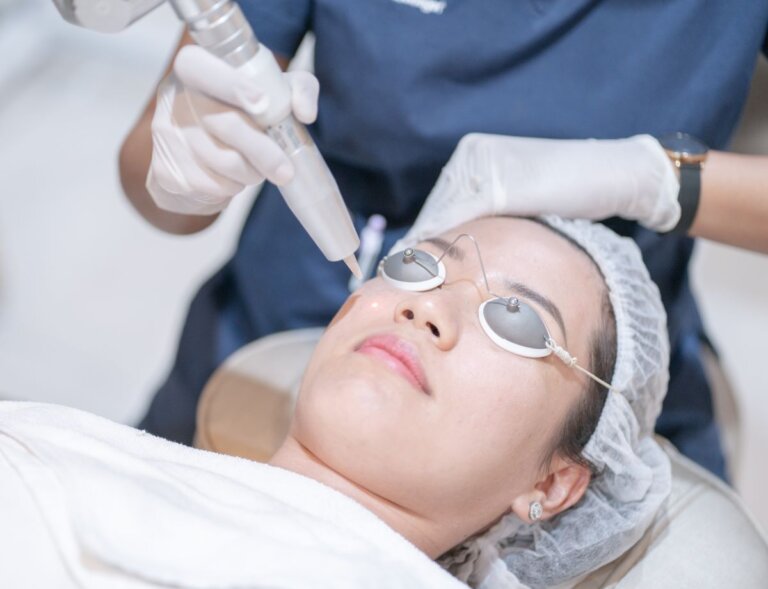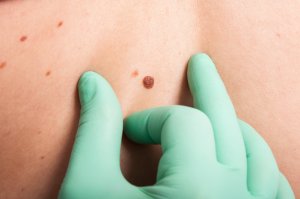pulsed dye laser
A Pulsed Dye Laser (PDL) is a type of vascular laser commonly used in cosmetic and dermatological conditions.
By emitting light at a specific wavelength, it is preferentially absorbed by haemoglobin, the red pigment within blood vessels.
- Professional | Established | Trusted
- Inflammatory Acne Vulgaris
- Post-acne red scars or PIE
- Portwine stains
- Haemangiomas
- Rosacea and facial broken capillaries
- Minimal downtime


How does Pulsed dye laser work?
Targeted Wavelength: PDL emits light at a specific wavelength, usually around 585 to 595 nanometers, which is selectively absorbed by hemoglobin, the red pigment in blood vessels.
Selective Photothermolysis: The principle behind PDL treatment is selective photothermolysis. The laser energy is preferentially absorbed by the targeted blood vessels, causing them to heat up and coagulate while sparing surrounding tissues.
Blood Vessel Destruction: The heat generated by the laser damages the walls of the blood vessels, leading to their collapse and eventual destruction.
what are the types of vascular laser?
There are several types of vascular lasers used in dermatology and cosmetic procedures, each with specific wavelengths and characteristics tailored to target different types of vascular lesions and skin conditions. Here are some of the commonly used types of vascular lasers:
Pulsed Dye Laser (PDL):
- Pulse dye laser emits light at a specific wavelength (usually around 585 to 595 nanometers) that is selectively absorbed by hemoglobin, the red pigment in blood vessels. PDL is highly effective in treating vascular lesions such as port wine stains, hemangiomas, rosacea, telangiectasia (spider veins), and certain types of scars. The ADVATx laser uses 589nm technology, whereas the VBeam uses a 595nm system.
Long Pulse Nd:YAG Laser:
- Neodymium-doped yttrium aluminum garnet (Nd:YAG) laser emits light at a longer wavelength (usually around 1064 nanometers) that can penetrate deeper into the skin compared to PDL. Nd:YAG lasers are commonly used to treat deeper or larger blood vessels, such as leg veins (varicose veins) and deeper telangiectasia.
KTP Laser:
- Potassium titanyl phosphate (KTP) laser emits light at a wavelength of 532 nanometers, targeting superficial blood vessels closer to the skin surface. KTP lasers are often used to treat small vascular lesions.
what are the indications for Pulsed dye laser ?
Inflammatory acne vulgaris is a common condition that presents as papules, pustules and comedomes. Pulse dye laser emits a specific wavelength of light to reduce inflammation, improve healing and reduce post-inflammatory erythema (PIE). Post-inflammatory erythema refers to persistent redness or discoloration left behind after acne lesions have healed.
From experience, Dr. Ng believes that while vascular laser may offer benefits for certain aspects of inflammatory acne, it is not a substitute for comprehensive acne management. The primary goals of acne treatment typically include reducing inflammation, controlling bacterial overgrowth, preventing new acne lesions from forming, and minimizing the risk of scarring
Pulse dye laser treatment is often used to address the visible signs and symptoms of rosacea, a chronic skin condition characterized by facial redness, flushing, visible blood vessels (telangiectasia), and in some cases, papules and pustules.
Pulse dye laser treatment is a commonly used method for addressing vascular birthmarks, also known as vascular anomalies or hemangiomas. These birthmarks are caused by abnormal growth of blood vessels in the skin and can manifest in various forms, including port wine stains, hemangiomas, and venous malformations.
Pulse dye laser treatment is sometimes used as a method for improving the appearance of stretch marks (also known as striae distensae). While PDL treatment may not completely eliminate stretch marks, it can help reduce their visibility by targeting the underlying vascular and pigmentary changes associated with stretch marks.
Pulse dye laser treatment can be effective in treating certain types of scars, particularly scars that are red or pink in color and raised or hypertrophic scars. Scars may result from trauma, surgery, burns of inflammation.
Pulse dye laser (PDL) treatment is an effective method for treating spider veins, medically known as telangiectasia. These are small, dilated blood vessels near the surface of the skin, often found on the nose, cheeks and thighs.
what is the procedure like?
Consultation: Before undergoing PDL treatment, you will have a consultation with your doctor. They will assess your skin condition, discuss your treatment goals, and determine if PDL is suitable for you.
Preparation: Depending on the area being treated, your skin may need to be cleaned and prepped beforehand. In some cases, a topical numbing cream may be applied to minimize discomfort during the procedure.
Treatment: During the procedure, you will be given protective eyewear to shield your eyes from the laser light. A handheld device delivers short bursts of laser energy to the targeted areas of your skin.
Sensation: You may feel a mild stinging or snapping sensation during the treatment, often described as similar to the snapping of a rubber band against the skin. However, discomfort is typically minimal and well-tolerated by most individuals.
Post-Treatment Care: After the procedure, your skin may appear slightly red and swollen, similar to a mild sunburn. You may be advised to apply a soothing cream or gel and avoid sun exposure for a few days following the treatment.
Multiple Sessions: Depending on the severity of your condition and your treatment goals, you may need multiple sessions of PDL treatment spaced several weeks apart to achieve optimal results.
what are the benefits of pulsed dye laser?
Selective Targeting: PDL selectively targets blood vessels while sparing surrounding tissues, minimizing the risk of side effects and downtime.
Effective: PDL is highly effective in treating various vascular lesions and cosmetic concerns associated with redness and skin discoloration.
Minimal Downtime: The procedure typically requires minimal downtime, and most individuals can resume their normal activities immediately after treatment.
Frequently Asked Questions About Pulsed Dye Laser
Most individuals tolerate PDL treatment well, and discomfort during the procedure is typically minimal. Some may experience a sensation of warmth or mild stinging during the laser pulses, but this is usually well-tolerated. Topical anesthesia or cooling techniques may be used to minimize discomfort.
The number of treatment sessions needed varies depending on the specific skin condition being treated, its severity, and individual response to treatment. In many cases, a series of treatments spaced several weeks apart is recommended to achieve optimal results.
Generally, there is minimal downtime after PDL treatment. Most individuals can resume their normal activities immediately after the procedure. Some temporary redness, swelling, or mild discomfort may occur, but these effects typically subside within a few days.
While PDL treatment is generally safe, some individuals may experience temporary side effects such as redness, swelling, bruising, or changes in skin pigmentation. Rarely, more serious side effects such as scarring or infection may occur. It’s essential to follow post-treatment care instructions provided by your healthcare provider to minimize the risk of complications.
The duration of results varies depending on the specific skin condition being treated, individual skin characteristics, and lifestyle factors. In some cases, maintenance treatments may be needed to sustain the desired results over time.
PDL treatment may not be suitable for individuals with certain medical conditions, such as bleeding disorders, active infections, or certain skin types. Pregnant women are generally advised to avoid PDL treatment due to potential risks to the fetus.
schedule a consultation for pulsed dye laser treatment in singapore
The introduction of the Pulse Dye Laser provides a safe and effective treatment option to address acne, scars, rosacea, vascular disorders and birthmarks. Contact us today to schedule a consultation, so Dr. Ng can develop a personalized treatment approach for resolving your skin concerns and helping you to achieve long-term improvements in the health and appearance of your skin.
Request a CallBack
Get in touch with us with any questions, pricing, or bookings.
Or give us a call at +65 6769 6007 | WhatsApp us +65 9855 3022
Related Information:
References:
- Seaton E, Charakida A, Mouser P. et al. Pulsed-dye laser treatment for inflammatory acne vulgaris: randomised controlled trial. Lancet.2003;362:1347-1352.
- Patel N, Clement M. Selective nonablative treatment of acne scarring with 585nm flashpump pulsed dye laser. Dermatol Surg.2002;28:942-945.
- Lonne-Rahm S, Nordlind K, Edstrom DW, Ros AM, Berg M. Laser treatment of rosacea: a pathoetiological study. Arch Dermatol. 2004 Nov. 140(11):1345-9.
- Li MK, Liu C, Hsu JT. The use of lasers and light devices in acne management: an update. American Journal of Clinical Dermatology. 2021 Nov;22:785-800.
- Kalantari Y, Dadkhahfar S, Etesami I. Post‐acne erythema treatment: A systematic review of the literature. Journal of Cosmetic Dermatology. 2022 Apr;21(4):1379-92.







